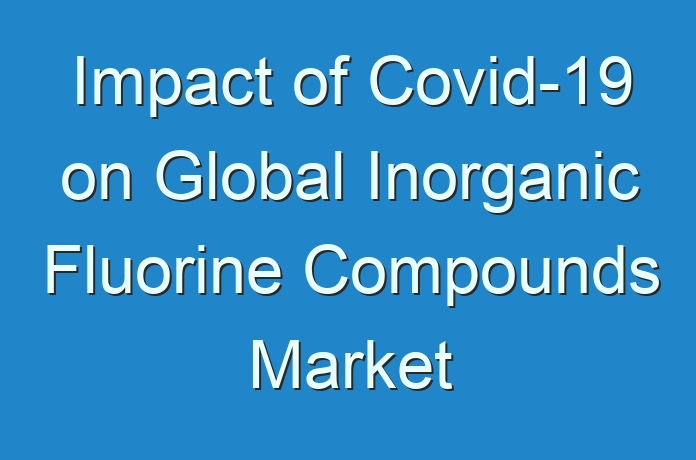
Inorganic Fluorine Compounds: Introduction
- Inorganic fluorine compounds are produced by the reaction of hydrofluoric acid with oxides, carbonates, hydroxides, chlorides, or metals. Hydrogen fluoride is an important compound of fluorides. It is the primary feedstock used in the production of inorganic and organic fluorine?bearing compounds. Aluminum fluoride is used in aluminum smelting.
- Acid of inorganic fluorine compound is characterized by the stability of its molecule. It has a special affinity for oxygen compounds. It is a strong acid, which gives it a catalytic activity in alkylation, isomerization, and polymerization reactions.
- Inorganic fluorine compounds are used in organic chemistry as fluorinating agents in substitution reactions with aliphatic halides. They are also used in reactions with unsaturated compounds.
Key Drivers of Inorganic Fluorine Compounds Market
- Inorganic fluorine compounds are extensively used as raw materials for downstream organic synthesis of specialty chemicals. These chemicals are in turn used to manufacture pharmaceuticals intermediates, synthetic resins, rubber accelerators, perfumes, crop protection chemicals, and pesticides. This is expected to drive the global inorganic fluorine compounds market during the forecast period.
- Inorganic fluorine compounds are primarily employed in the iron & steel industry. They are used as flux in the manufacture of steel. They help lower the melting point of steel. Inorganic fluorine compounds are employed in the manufacture of cast iron at the rate of 6 kg/t – 8 kg/t of metal, and also in the manufacture of certain ferroalloys.
- Inorganic fluorine compounds constitute 5% to 7% of the aluminum electrolysis bath. They are used in numerous fluxes and, in particular, for welding rod coatings.
Hydrogen Fluoride Type Segment to Offer Attractive Opportunities
- In terms of revenue, the hydrogen fluoride type segment is estimated to hold significant share of the market in the near future owing to the high demand for hydrogen fluoride in various specialty chemicals. Hydrogen fluoride is the raw material used in the production of fluorocarbons, which are employed in refrigeration and air conditioning, and as precursors to fluoropolymers and elastomers. Additionally, hydrogen fluoride serves as a catalyst in petroleum alkylation, a process used for gasoline manufacture. It is also used in metal treatment and production of uranium fuel.
Request Sample
https://www.transparencymarketresearch.com/sample/sample.php?flag=S&rep_id=78363
Covid-19 Impact on Inorganic Fluorine Compounds Market
- According to the International Monetary Fund (IMF), the world economy is expected to experience the worst recession since the Great Depression (1929–1933) in the near future. The chemical industry is also likely to feel the impact of the coronavirus pandemic. The chemical industry in China is dominant across the globe. According to the European Chemical Industry Council (Cefic) report titled ‘2020 Facts and Figures of the European Chemical Industry,’ China was the largest producer of chemicals in the world, contributing 35.8% to global chemical sales in 2018. However, according to the National Bureau of Statistics of China, chemical manufacturing output declined by 21%, while profits decreased by 66% in the first two months of 2024 due to the coronavirus pandemic.
- The chemical sector’s supply chain has historically been strongly dependent on China. However, it has been significantly impacted by the COVID-19 pandemic. Logistics within China has also been a matter of concern during the pandemic, as it significantly affects the sales of chemical production companies.
- In April 2024, the prices of crude oil suffered its biggest decline since the start of the Gulf War in 1991. This collapse caused a major shift in prices of chemical feedstock and the global competitive order. The U.S., losing its cost advantage from shale gas, and the Middle East have been negatively impacted. Therefore, the impact of Covid-19 pandemic is estimated to be high on the inorganic fluorine compounds market in 2024 and 2024.
More Trending Reports
Volatility in Raw Material Prices to Hamper Market
- The global inorganic fluorine compounds market is primarily hampered by the high cost of raw materials
- Inorganic fluorine compounds are petroleum derived products. The prices of these products are fluctuating due to the global crisis of oil. Thus, volatility in raw material prices is likely to restrain the inorganic fluorine compounds market.
Request Covid19 analysis on this market
https://www.transparencymarketresearch.com/sample/sample.php?flag=covid19&rep_id=78363
Asia Pacific to Hold Major Share of Global Inorganic Fluorine Compounds Market
- In terms of geography, the global inorganic fluorine compounds can be split into North America, Europe, Asia Pacific, Latin America, and Middle East & Africa
- Asia Pacific is estimated to account for major share of the global market, owing to the presence of numerous glass and chemical companies in the region. The inorganic fluorine compounds market in China is anticipated to hold prominent share of the market during the forecast period, due to the presence of several chemical industries in the country.
- The market in North America is projected to expand at a rapid pace during the forecast period, due to an increase in the production of metal products across the region
Buy Now
https://www.transparencymarketresearch.com/checkout.php?rep_id=78363<ype=S
Key Players in Market
The global inorganic fluorine compounds market is highly concentrated, with the top manufacturers accounting for approximately 35%–40% of the share. Major players operating in the global inorganic fluorine compounds market include:
- BASF
- Eastman Chemical Company
- Solvay
- Mitsubishi Chemical Corporation
- OXEA Corporation
- Perstorp Holding AB
- The Dow Chemical Company





